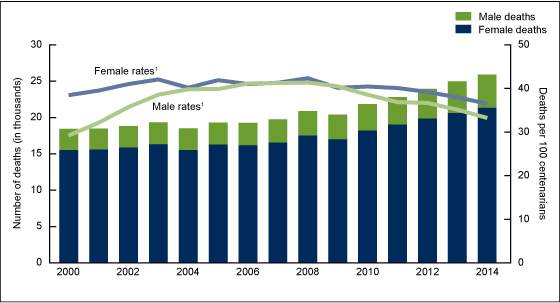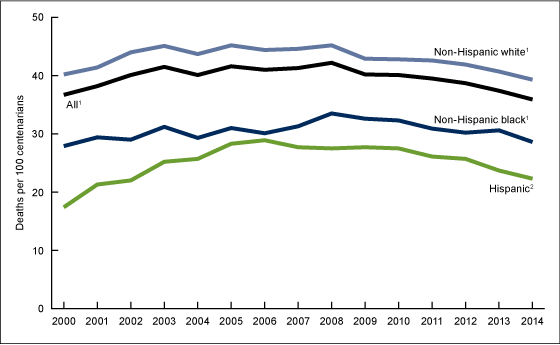Mortality Among Centenarians in the United States, 2000─2014
NCHS Data Brief No. 233, January 2016
On This Page
- Key findings
- Death rates increased from 2000 through 2008 and then decreased through 2014 for both male and female centenarians.
- The death rate was highest for non-Hispanic white centenarians, followed by non-Hispanic black and Hispanic centenarians, throughout the period.
- Death rates increased in 2014 compared with 2000 for 4 of the 10 leading causes of death among centenarians in 2014 and decreased for 3 causes.
- In 2014, the top five causes of death for centenarians were heart disease, Alzheimer’s disease, stroke, cancer, and influenza and pneumonia.
- Summary
- Definitions
- Data source and methods
- About the author
- References
- Suggested citation
PDF Version (352 KB)
Jiaquan Xu, M.D.
Key findings
Data from the National Vital Statistics System, Mortality
- Death rates for centenarians increased from 2000 through 2008 and then decreased through 2014 for both males and females.
- Death rates for centenarians increased from 2000 through 2006 for the Hispanic population and from 2000 through 2008 for the non-Hispanic white and black populations, and subsequently decreased through 2014 for all racial and ethnic groups examined.
- The top five causes of death among centenarians in 2014 were heart disease, Alzheimer’s disease, stroke, cancer, and influenza and pneumonia.
- Death rates for Alzheimer’s disease increased 119% between 2000 and 2014 among centenarians.
The population of the United States is aging. Although centenarians are still uncommon, the numbers of Americans aged 100 and over increased 43.6%, from 50,281 in 2000 to 72,197 in 2014 (1,2). As the number of centenarians increases, so does the number of deaths in this age group (3). National Vital Statistics System mortality data filed by the 50 states and the District of Columbia for years 2000 through 2014 were analyzed to determine the number of deaths, age-specific death rates by race and ethnicity, and sex-specific leading causes of death among centenarians.
Keywords: vital statistics, leading cause, death rates, National Vital Statistics System
Death rates increased from 2000 through 2008 and then decreased through 2014 for both male and female centenarians.
- The number of deaths for people aged 100 and over increased 41%, from 18,434 in 2000 to 25,914 in 2014 (Figure 1). Deaths among females accounted for more than 82% of all deaths each year from 2000 through 2014.
- The death rate for female centenarians increased 10%, from 38.5 per 100 female centenarians in 2000 to 42.4 in 2008. The rate then decreased 14% through 2014.
- The death rate for male centenarians increased 41%, from 29.2 in 2000 to 41.3 in 2008. The rate then decreased 20%, to 33.2 in 2014.
Figure 1. Number of deaths and death rates for centenarians, by sex: United States, 2000–2014
1Linear increase from 2000 to 2008 and decrease from 2008 to 2014 are statistically significant at
p < 0.05 level.
NOTE: Access data table for Figure 1.
SOURCE: CDC/NCHS, National Vital Statistics System, Mortality.
The death rate was highest for non-Hispanic white centenarians, followed by non-Hispanic black and Hispanic centenarians, throughout the period.
- The death rate for non-Hispanic white centenarians was the highest among the three race and Hispanic origin groups examined from 2000 through 2014, followed by non-Hispanic black and Hispanic centenarians (Figure 2).
- The death rate for Hispanic centenarians increased 66%, from 17.4 in 2000 to 28.9 in 2006. The rate then decreased 23%, to 22.3 in 2014.
- Death rates increased 13% for non-Hispanic white centenarians and 20% for non-Hispanic black centenarians from 2000 through 2008. The rates then decreased 13% for non-Hispanic white and 15% for non-Hispanic black centenarians by 2014.
Figure 2. Death rates for centenarians, by race and Hispanic origin: United States, 2000–2014
1Linear increase from 2000 to 2008 and decrease from 2008 to 2014 are statistically significant at
p < 0.05 level.
2Linear increase from 2000 to 2006 and decrease from 2006 to 2014 are statistically significant at
p < 0.05 level.
NOTE: Access data table for Figure 2.
SOURCE: CDC/NCHS, National Vital Statistics System, Mortality.
Death rates increased in 2014 compared with 2000 for 4 of the 10 leading causes of death among centenarians in 2014 and decreased for 3 causes.
- Death rates for centenarians increased 119% for Alzheimer’s disease, 88% for hypertension, 34% for chronic lower respiratory diseases (CLRD), and 33% for unintentional injuries between 2000 and 2014 (Figure 3).
- The rates decreased 48% for influenza and pneumonia, 31% for stroke, and 24% for heart disease between 2000 and 2014.
- The changes in death rates for kidney disease, cancer, and pneumonitis due to solids and liquids were not statistically significant between 2000 and 2014.
Figure 3. Percent change in death rates for the top 10 causes of death among centenarians in 2014: United States, 2000 and 2014
1Significantly different from 2000 at p < 0.01 level.
2Pneumonitis due to solids and liquids replaced atherosclerosis as the 10th leading cause of death in 2014.
NOTES: Order for causes of death is based on the 2014 cause-of-death ranking. CLRD is chronic lower respiratory diseases. Access data table for Figure 3.
SOURCE: CDC/NCHS, National Vital Statistics System, Mortality
In 2014, the top five causes of death for centenarians were heart disease, Alzheimer’s disease, stroke, cancer, and influenza and pneumonia.
- For all centenarians, the top five causes of death in 2000 were heart disease, stroke, influenza and pneumonia, cancer, and Alzheimer’s disease (Figure 4). In 2014, heart disease was still the leading cause of death, but Alzheimer’s disease became the second leading cause, followed by stroke, cancer, and influenza and pneumonia.
- For female centenarians, the top five causes of death in 2000 were heart disease, stroke, influenza and pneumonia, Alzheimer’s disease, and cancer. In 2014, heart disease was still the leading cause, followed by Alzheimer’s disease, stroke, influenza and pneumonia, and cancer.
- For male centenarians, the top five causes of death in 2000 were heart disease, influenza and pneumonia, stroke, cancer, and CLRD. In 2014, Alzheimer’s disease replaced CLRD as the fifth leading cause of death, and cancer became the second leading cause.
- Between 2000 and 2014, the percentage of total deaths decreased significantly for heart disease, stroke, and influenza and pneumonia among both male and female centenarians. Increases were seen for Alzheimer’s disease for both males and females.
Figure 4. Percentage of total deaths for top five causes of death among centenarians, by sex: United States, 2000 and 2014
1Decreased significantly from 2000 at p < 0.01 level.
2Increased significantly from 2000 at p < 0.01 level.
NOTE: CLRD is chronic lower respiratory diseases.
SOURCE: CDC/NCHS, National Vital Statistics System, Mortality.
Summary
As the population in the United States has aged, the number of deaths among centenarians continues to increase (3). This report provides the most up-to-date mortality profile for U.S. centenarians for the last 15 years. Death rates increased for both male and female centenarians from 2000 through 2008 and decreased from 2008 through 2014. Deaths for females accounted for more than 82% of total deaths each year, and females accounted for 80%–84% of the total centenarian population from 2000 through 2014. The death rate was highest for non-Hispanic white centenarians, followed by non-Hispanic black and Hispanic centenarians throughout this period. Heart disease remained the leading cause of death in 2014 as in 2000 for both male and female centenarians. The percentage of total deaths from Alzheimer’s disease increased 124% between 2000 and 2014.
Definitions
Cause-of-death classification: Cause of death is determined based on medical information, including injury diagnoses and external causes of injury, that is entered on death certificates filed in the United States. This information is classified and coded in accordance with the International Statistical Classification of Diseases and Related Health Problems, Tenth Revision (ICD–10) (4).
Centenarians: Those aged 100 and over, as reported on death certificates filed by the 50 states and the District of Columbia.
Leading cause of death: Ranked according to the number of deaths assigned to rankable underlying causes of death (5).
Underlying cause of death: Defined by the World Health Organization as “the disease or injury which initiated the train of events leading directly to death, or the circumstances of the accident or violence which produced the fatal injury” (4). It is selected from the condition entered by the medical certifier in the cause-of-death section of the death certificate.
Data source and methods
All data in this report are from mortality files for the 50 states and the District of Columbia filed with the National Vital Statistics System for 2000 to 2014 (6). Death rates are based on intercensal estimates as of July 1, 2000 through 2009, and postcensal estimates as of July 1, 2010 through 2014, that are consistent with the April 1, 2000, and April 1, 2010, censuses (7). The significance of trends was tested using the Joinpoint Regression Program (8). Differences between percentages were evaluated using a two-tailed z test.
About the author
Jiaquan Xu is with CDC’s National Center for Health Statistics, Division of Vital Statistics, Mortality Statistics Branch.
References
- U.S. Census Bureau. Population estimates: National intercensal estimates (2000–2010). Intercensal estimates of the resident population by single year of age, sex, race, and Hispanic origin for the United States: April 1, 2000 to July 1, 2010.
- U.S. Census Bureau. Population estimates: Postcensal estimates for 2010–2014.
- Xu JQ. Quick Stats: Number of deaths among centenarians and percentage among all deaths, by sex—United States, 1980–2010. MMWR 62(46):941. 2013.
- World Health Organization. International statistical classification of diseases and related health problems, tenth revision (ICD–10). 2008 ed. Geneva, Switzerland. 2009.
- Heron M. Deaths: Leading causes for 2012. National vital statistics reports; vol 64 no 10. Hyattsville, MD: National Center for Health Statistics. 2015.
- National Center for Health Statistics. Vital statistics data available online. Mortality multiple cause files.
- National Center for Health Statistics. National Vital Statistics System: U.S. census populations with bridged race categories.
- National Cancer Institute. Joinpoint Regression Program (Version 4.1.1.) [computer software]. 2014.
Suggested citation
Xu JQ. Mortality among centenarians in the United States, 2000–2014. NCHS data brief, no 233. Hyattsville, MD: National Center for Health Statistics. 2016.
Copyright information
All materials appearing in this report is in the public domain and may be reproduced or copied without permission; citation as to source, however, is appreciated.
National Center for Health Statistics
Charles J. Rothwell, M.S., M.B.A., Director
Nathaniel Schenker, Ph.D., Deputy Director
Jennifer H. Madans, Ph.D., Associate Director for Science
Division of Vital Statistics
Delton Atkinson, M.P.H., M.P.H., P.M.P., Director
Hanyu Ni, Ph.D., M.P.H., Associate Director for Science
- Page last reviewed: January 21, 2016
- Page last updated: January 21, 2016
- Content source:


 ShareCompartir
ShareCompartir



